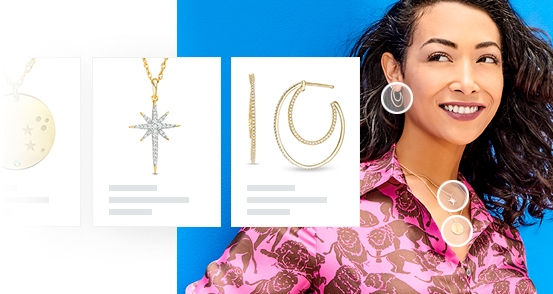Zales Round-Cut Diamonds
Imagine: a delicate gold chain framing her neck with an elegant round diamond centerpiece. Or, picture your partner’s ring finger wrapped around a champagne glass, raised in a toast to your engagement. You think: “the only thing more radiant than that new round-cut engagement ring is my partner's smile”.
What is it that makes this moment? Maybe it's that look across the dinner table during your anniversary where her round diamond earrings twinkle in the candlelight. As one of the most popular cuts, the brilliant shine of the round-cut diamond lends well to a variety of settings.
What is a Round-Cut Diamond?
Round diamonds are the most popular diamond shape, making up nearly three-quarters of all diamond sales worldwide. Known for their brilliance and stunning beauty, round-cut diamonds offer fire, brilliance, and scintillation that is unattainable by other shapes.
Today’s round diamonds are based on generations of research into round diamond cuts with the intent of creating the most ideal shape for ultimate brilliance. At least six ideal cuts have been devised throughout round-cut diamond history, all working toward modern day’s brilliant round-cut diamonds.
These ideal cuts include:
- Practical Fine Cut
- Parker Brilliant
- Ideal Brilliant
- Eulitz Brilliant
- American Standard
Each of these cuts features unique benchmarks for crown height, pavilion depth, table diameter, girdle thickness, crown angle, and pavilion angle – adding up to a unique level of brilliance.
What Do You Call a Round-Cut Diamond?
The shape of a round-cut diamond is made up of 57 or 58 facets (sides), including the culet – the flat face on the bottom of the diamond. The culet is the tiny point at the base of the diamond. In a uniformly cut diamond, the facets should meet at a perfect point – these diamonds will have no culet. When a culet is present, the diamond is referred to as having 58 facets.
The diamond industry recognizes two distinct types of round-cut diamonds:
Brilliant-Cut Round Diamonds
The brilliant cut diamond utilizes its facets to reflect white light particularly well. With this diamond cut, angles and proportions work together to reflect light brilliantly. Brilliant cut diamonds are classified as having a medium to large culet, and a lower half that is 65 percent or less of the total length of the diamond. For modern jewelry with a beautiful sparkle, Brilliant cut round diamonds are an excellent choice.
Old European-Cut Round Diamonds
The old European cut round diamond was created before modern diamond technology and was popular prior to the 20th century. Because of this, these diamonds generally have deeper proportions than the round brilliant cut diamond. Old European cut diamonds were primarily cut for their color. If your partner prefers a more vintage jewelry look, the Old European Cut might just be the perfect choice.
When comparing brilliant cut and old European cut diamonds, the main difference is in the facets: the old European cut features facets with triangular blocks, where the round brilliant diamond has thinner kite-shaped facets. The two different styles each reflect light in uniquely beautiful ways.
During the process of cutting a round diamond, much of the rough diamond is lost. Because of this, round-cut diamonds tend to be more expensive than other shapes of the same size. However, because of the way they are cut, round diamonds hold the appearance of being the largest of all shapes with the same carat size. Because of the size and brilliant beauty of round-cut diamonds, society continues to favor the shape for use in beautiful fine jewelry such as engagement rings and necklaces.
Grading System of Zales Round-Cut Diamonds
At Zales, we rely on the trusted experts at GL Laboratories (GSL) to grade our precious stones.
GSL was incorporated in 1985 as an independent laboratory for providing unbiased professional diamond grading. For grading a diamond, GSL inspects each diamond under closely controlled lighting and viewing conditions. Trained grading professionals use highly-calibrated measurement devices to capture important data for use in determining the round diamond’s quality. The experts at GSL grade our round-cut diamonds on the following determinations:
Round-Cut Carat
The weight of the diamond is measured using the carat system. GSL uses specialized scales to ensure an accurate weight measurement – the weights are measured to the hundred-thousandths of a carat. With the carat system, one metric carat is equal to 0.2 gram.
Round-Cut Clarity
Round diamond clarity refers to the appearance of the stone, and it notes any blemishes or inclusions. The GSL grades round diamond clarity as one of six grades – Flawless, Internally Flawless, Very Very Small Inclusions, Very Small Inclusions, Small Inclusions, or Imperfect.
Most importantly when looking at the clarity of a diamond is whether or not the diamond appears to be clear to the human eye. Many blemishes may only be visible to a professional with highly specialized equipment. When looking at diamonds, much of the decision process is subjective – some people may prefer knowing that their diamond is certified as flawless while others may be okay with minor blemishes that are invisible to the naked eye. If your partner prefers a more flawless appearance for their diamond jewelry, you’ll want to choose a Flawless or Internally flawless diamond. If small imperfections do not stand out to your partner, then a Very Small Inclusions or Small Inclusions grade may be preferred.
Round-Cut Color
The industry standard for grading round diamond color is a system that begins with a D grade (colorless), and continues with increasing levels of color to a Z Grade. Diamonds are compared to master stones with known color grades – GSL utilizes master stone sets that are rigorously chosen and tested prior to use.
To the naked eye, the color of the diamond is closely tied to the size of the round diamond and the setting. Small differences in round diamond color are difficult to see for the human eye, but they will account for a large difference in the price of the diamond. Additionally, the setting color and material chosen for the round-cut diamond can make an immense difference in the color of the diamond. Ideally, a diamond should always look colorless against its setting, so keep in mind what the setting will look like when shopping for diamond color.
Round-Cut Quality
The proportions of a round-cut diamond determine how brilliantly the diamond will shine. Grading of a diamond’s cut is determined by examining its angles, facets, and polish. The goal with attaining a good cut of diamond is to create a diamond that has the correct proportions to allow the maximum amount of light to travel through, which will give the diamond a beautiful sparkle that your partner will love. Each diamond is given one of the following grades for cut: Ideal, Excellent, Very Good, Good, Medium, Fair, or Poor. A high-quality diamond cut will feature proportions that allow optimal light reflection through the crown and table – giving off a beautiful, brilliant sparkle.
History of the Round-Cut Diamond
Round diamonds are the most popular diamond choice in society today – accounting for as much as 75 percent of diamond sales. With modern diamond cutting technologies, round-cut diamonds are even more brilliant than ever before.
The popularity of round diamonds is nothing new. The shape gained traction in 1919, the year that Marcel Tolkowsky published his thesis titled “Diamond Design: A Study of the Reflection and Refraction of Light in a Diamond”. In his thesis, Tolkowsky discussed the ideal cut of diamond for optimal brilliance and shine, citing specific angles and proportions as being useful to maximize brilliance. Tolkowsky’s work created a surge of popularity for the round-cut diamond, and the shape has remained as the most popular diamond shape ever since.
If your goal is to find a timeless and beautiful diamond, then a round-cut diamond may be the perfect option. Round diamonds are fashioned to meet modern concepts of beauty – often described as being classic and elegant. The GSL grades round-cut diamonds on a number of classifications, ensuring that each Zales diamond meets the high-quality standards the industry demands.
Round-Cut Diamonds: Conclusion
For centuries, round diamonds have been the most popular diamond shape in the consumer market – especially popular for engagement rings, necklaces, and other fine jewelry. This brilliant shape of diamond is fashioned to meet modern concepts of beauty, with a timeless and classic style. Round-cut diamonds feature incredible brilliance and fire that sparkles in the light, made possible by strict guidelines for ideal proportions. These guidelines evaluate the round diamond’s facet shape, angles, girdle width, culet size, polish, and symmetry to determine the grade of the diamond.
For a classic and beautiful diamond option, the ideal proportions of round-cut diamonds offer timelessness and elegance, as well as brilliant shine. As the most researched diamond shape in the industry, the round-cut is backed by advanced scientific theories of light reflection, mathematical calculations, and centuries of modernization.
Browse our selection of unique Zales round-cut diamonds to find the round-cut that shines as bright as your partner.





 They will be on video but won't see you.
They will be on video but won't see you. Make sure to enable your mic if prompted.
Make sure to enable your mic if prompted. Language:
Language:
